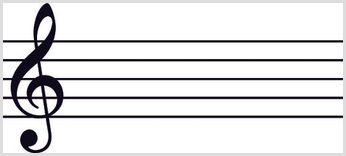Reading and writing music starts with the Stave, also known as the Staff. The stave is five lines stacked on top of each other. We draw notes on the stave and the height of the note decides how high it will sound: if the note is high on the Stave it will be a high note, and vice versa. This is also known as the Pitch of the note.
When you're playing and you reach the end of a stave, you move to the stave below. You play like you're reading a book, from left to right and from top to bottom. Vertical lines are drawn in the stave and this breaks the music down into blocks, like bricks in a house. Each of these blocks is called a Bar, which contains notes and/or silences called Rests. The number at the start of each stave tells you what bar number starts the line.
There are two types of notes on the stave: space notes and line notes. Space notes are notes that are squashed between the lines. Line notes are notes where the line goes through the middle of the note. There are four space notes and five line notes. There are rhymes to help you remember the notes for space and line notes, including All Cows Eat Grass.
Another name you may come across is a Grand Staff. It sounds like something out of Lord of The Rings but is all to do with the keyboard. The keyboard has two Staves per line, one stave for the right hand on top and one for the left hand underneath. There's a wavy line at the start of each Grand Staff showing that these staves are combined, meaning you play both at the same time e.g. if you had a note in the right hand stave and a note directly underneath in the left hand stave, you'd play these notes at the same time. The easiest way to remember this is to imagine a vertical line representing time: as the line moves across the Grand Staff, you play whatever the next note is, whether it's in the right, left, or both.
This post was updated on 01 Aug, 2023.

